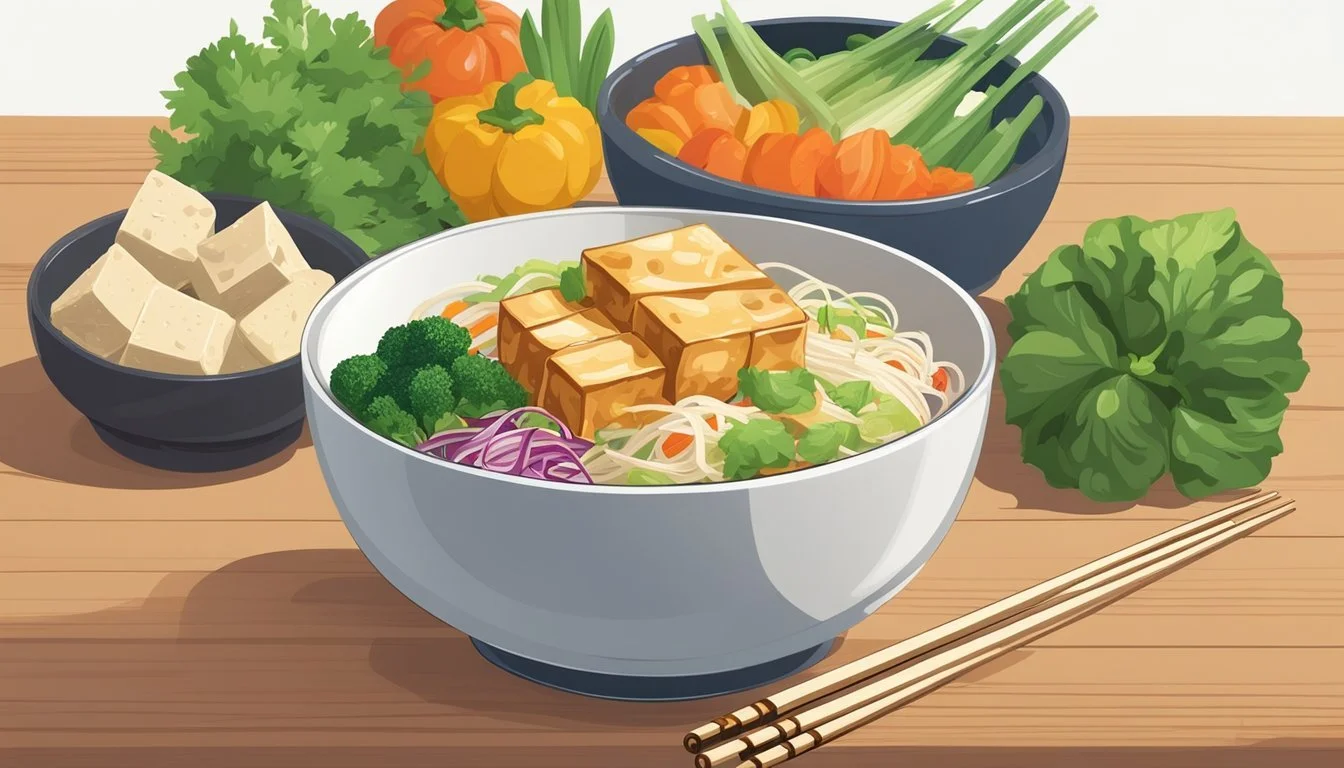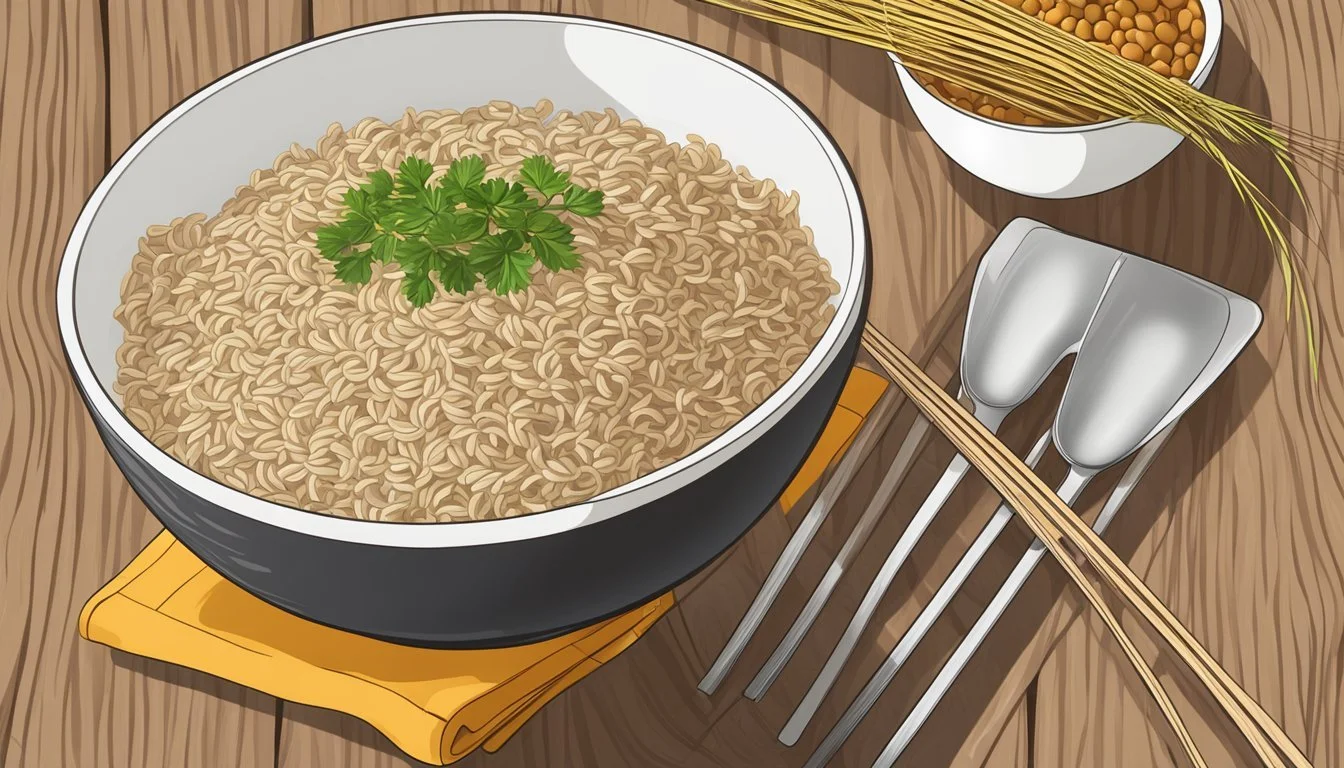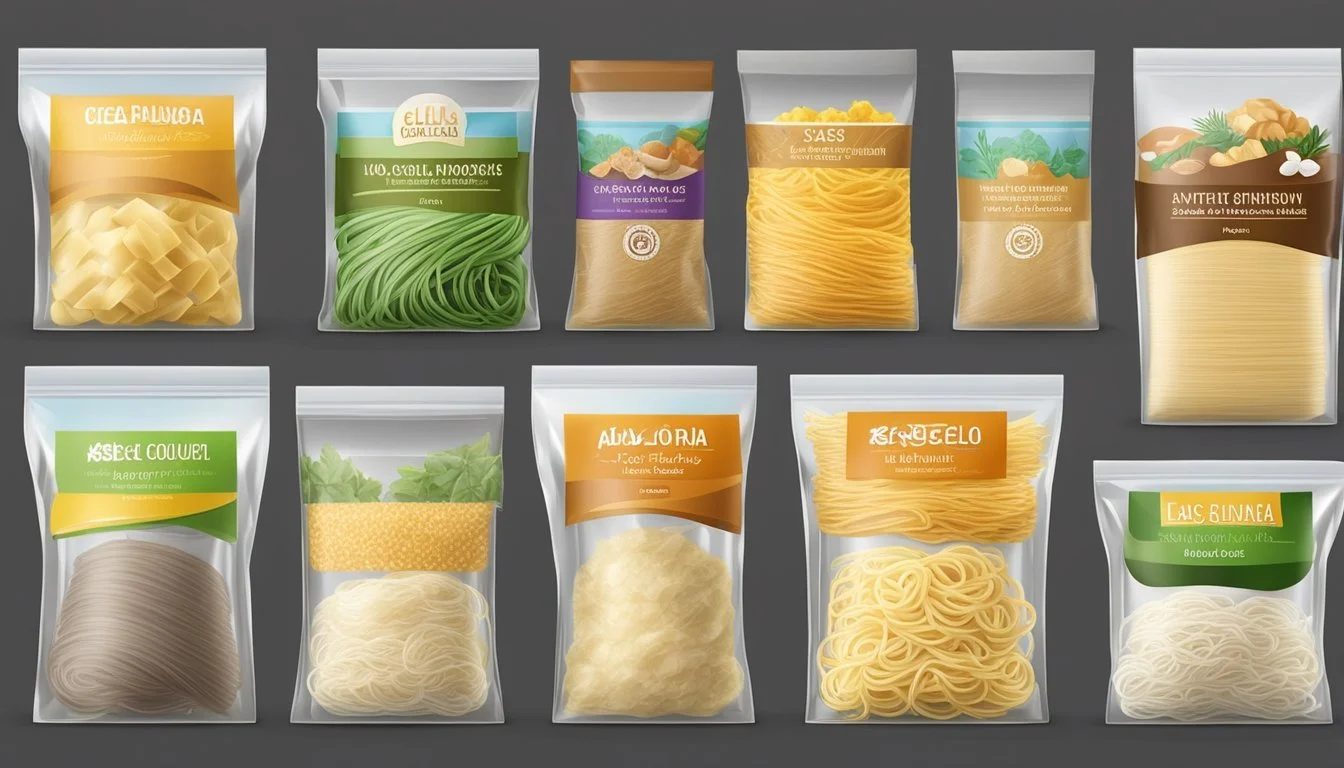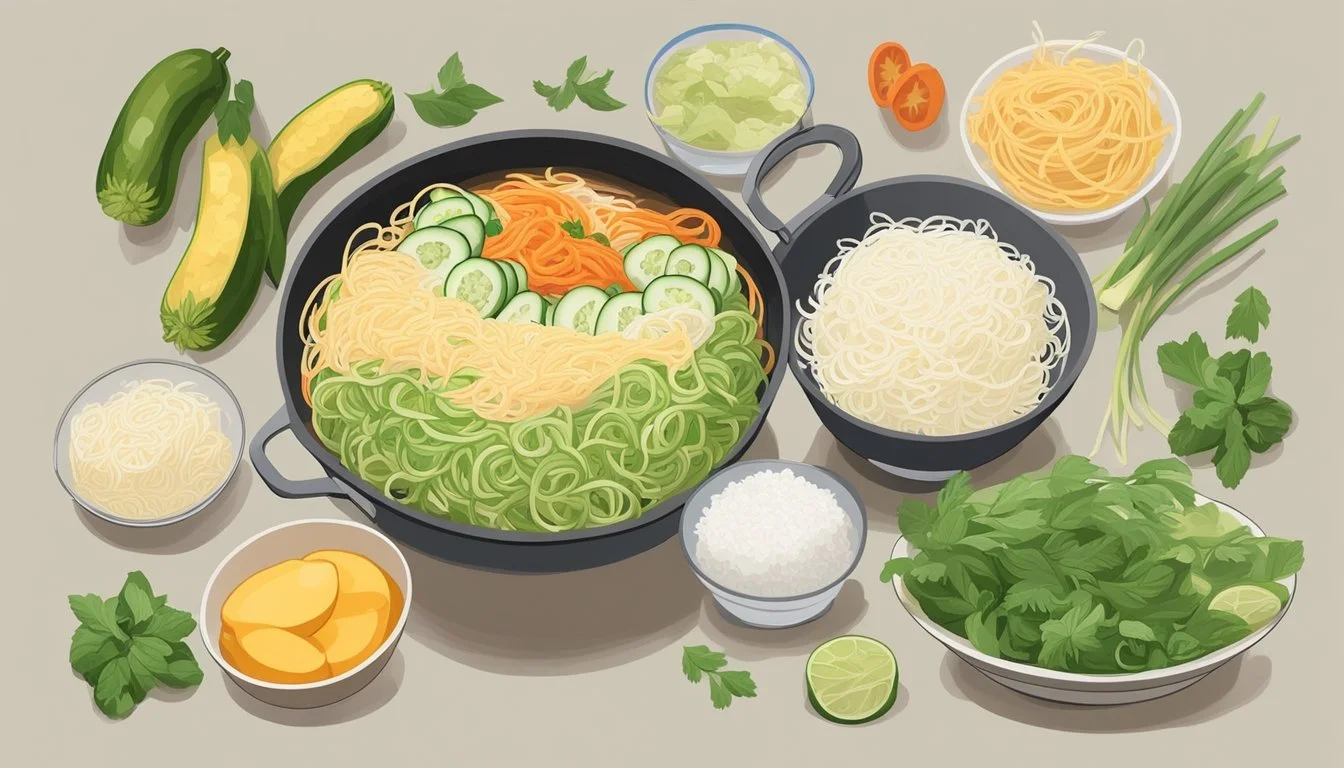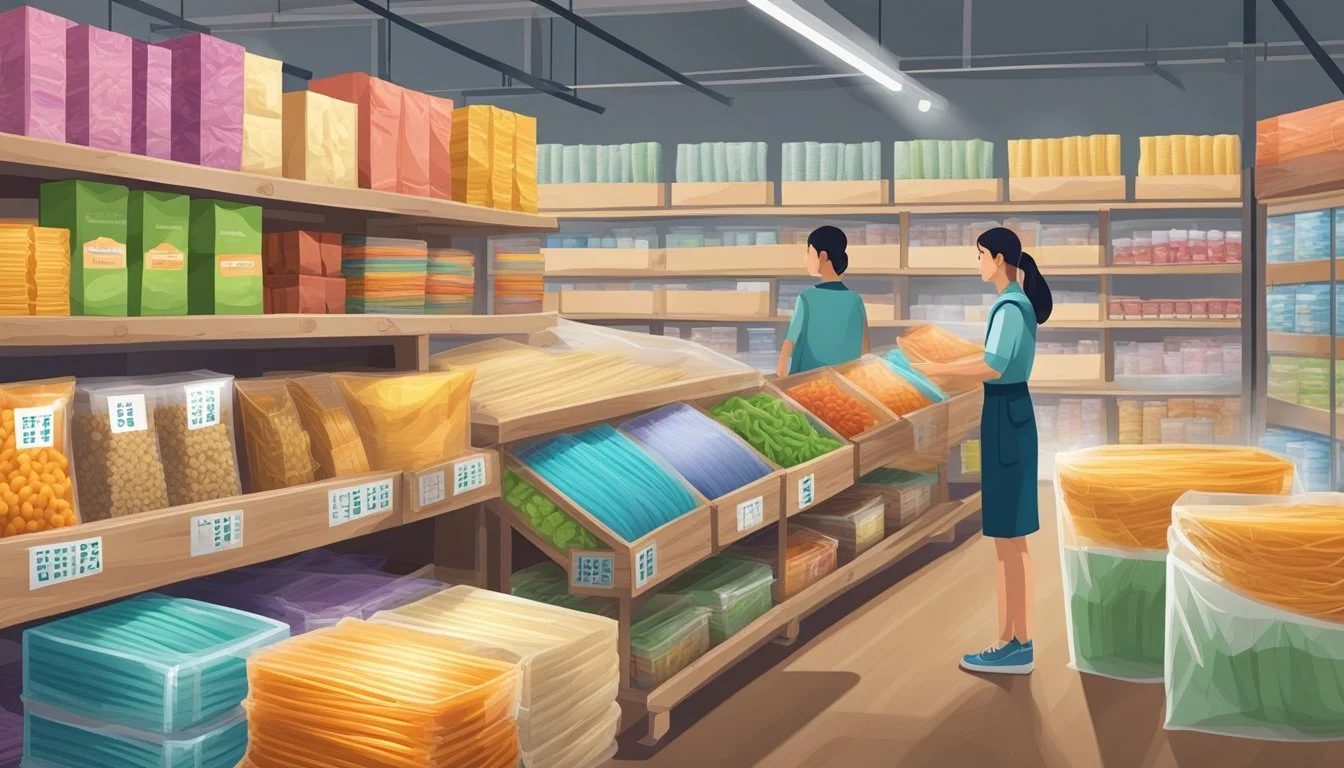Cellophane Noodles Substitutes
Top Alternatives for Your Recipes
Cellophane noodles, also known as glass noodles, are a staple ingredient in various Asian cuisines. Made from starch such as mung bean, potato, or tapioca, these noodles are prized for their unique, transparent appearance and their ability to absorb the flavors of the dishes they are incorporated into. Their versatility and delicate texture make them a popular choice for stir-fries, soups, and salads.
Finding the right substitute for cellophane noodles can be crucial for those looking to replicate the textural qualities and flavor absorption of this ingredient when it's unavailable or for dietary reasons. Suitable alternatives include rice vermicelli, which offers a similar chewy texture, and zucchini noodles, which cater to a gluten-free and low-carb option, while still maintaining the ability to blend well with bold seasonings and sauces.
Adjustments in cooking methods and preparation may be necessary when opting for substitutes, as each alternative brings its own unique characteristics to a dish. It is essential to consider the desired outcome of the recipe when selecting a substitute to ensure the integrity of the dish remains intact.
Understanding Cellophane Noodles
Cellophane noodles, often known as glass noodles, are a type of transparent noodle made predominantly from mung bean starch, and sometimes from potato starch or various other starches. They are named for their translucent appearance after cooking. Unlike traditional wheat-based noodles, cellophane noodles do not contain gluten, making them a suitable option for those with gluten sensitivities.
When it comes to texture, these noodles offer a unique chew that is different from typical pasta. The chewy texture allows them to absorb flavors from sauces and broths, becoming more pronounced when combined with a blend of savory ingredients. Preparing cellophane noodles typically involves soaking them in water. To prepare, one must soak the noodles in hot water until they are soft, which usually takes around 10 to 15 minutes. This process rehydrates the noodles, allowing them to expand and become flexible.
To give a clear outline on how to soak cellophane noodles, see the following steps:
Place the noodles in a large heatproof bowl.
Pour boiling water over the noodles, ensuring they are fully submerged.
Let the noodles sit until they are soft, for about 10 to 15 minutes.
Drain the noodles and incorporate them into your desired dish.
Due to their simple composition of starch and water and the absence of a strong inherent flavor, cellophane noodles pair well with a variety of ingredients. They are famously utilized in Asian cuisine, enhancing the culinary experience by providing a gentle chew and allowing the accompanying flavors to shine.
Popular Cellophane Noodle Dishes
Cellophane noodles, also known as glass noodles, are a staple in various Asian cuisines. They're often used in a range of dishes due to their ability to absorb flavors and provide a unique texture. Here are some popular dishes that feature cellophane noodles:
Japchae: This Korean dish consists of stir-fried cellophane noodles with a variety of vegetables and sometimes meat. It's seasoned with soy sauce, sesame oil, and sugar, balancing sweet and savory notes.
Spring Rolls: Cellophane noodles are commonly found in these Asian appetizers, where they are mixed with vegetables, and sometimes shrimp or pork, before being wrapped in rice paper.
Hot Pot: In many Asian hot pot dishes, cellophane noodles are served as one of the accompaniments. They cook quickly in the simmering broth and absorb the rich flavors.
Soups: Various soups in Asian cuisine feature cellophane noodles for their texture. They often are included in light broth soups with vegetables and protein, like chicken or seafood.
Salads: In particular, Thai and Vietnamese salads might include cellophane noodles as a base, tossing them with a tangy sauce, herbs, and proteins such as grilled beef or seafood.
While these dishes showcase cellophane noodles, they can be substituted depending on availability and dietary needs. It's essential for cooks to choose a substitute that complements the flavors and textures of the original dish.
Why Substitute Cellophane Noodles?
There are several reasons a person might seek substitutes for cellophane noodles. Dietary restrictions often guide food choices, and for individuals with gluten allergies or sensitivities, cellophane noodles present a safe option as they are typically gluten-free, being made from starch such as mung bean or potato. However, not all cellophane noodles are certified gluten-free, and cross-contamination could be a concern for people with celiac disease or non-celiac gluten sensitivity.
Adaptation for dietary preferences is another reason; those adhering to a low-calorie or low-carbohydrate diet might opt for alternatives. Vegetables like zucchini can be spiralized to mimic the noodle shape while providing a nutritious and lighter option.
The texture of cellophane noodles is another aspect to consider. Certain recipes may require a different consistency or bite, and substitutes like rice vermicelli can offer a chewier texture which can enhance the eating experience of a dish.
The flavor profile is significant as well. Cellophane noodles are known for their ability to absorb surrounding flavors seamlessly. While this can be desirable, some dishes might benefit from alternative noodles that impart their own subtle taste, providing a different dimension to a meal.
Lastly, availability can lead to the need for noodle substitution. Cellophane noodles might not be readily available in all regions, prompting cooks to use more accessible noodles without compromising the dish’s integrity.
Conclusively, substitutes are often sought to accommodate dietary needs, provide nutritional benefits, alter texture and flavor, or simply due to availability.
Rice-Based Noodles Substitutes
When seeking alternatives to cellophane noodles, various rice-based noodles can offer a satisfying replacement that captures similar textures and flavors. These substitutes vary in thickness, chew, and cooking times, facilitating a range of Asian-inspired dishes.
Rice Vermicelli Noodles
Rice Vermicelli Noodles are thin rice noodles known for their soft texture and slight chew. They are typically used in dishes like spring rolls and salads. Due to their translucency and delicate structure, they make a suitable stand-in for cellophane noodles in lighter recipes.
Thick Rice Noodles
Thick Rice Noodles present a chewier and more substantial bite compared to the finer types. Their robust texture is well-suited for heartier meals such as stews and stir-fries. When substituting for cellophane noodles, consider adjusting cooking times as these noodles may require a longer period to soften.
Thin Rice Noodles
Thin Rice Noodles, also referred to as angel hair pasta or capellini, can be a viable substitute for cellophane noodles in various dishes. These noodles offer a transparent look and a texture that is softer compared to thicker varieties, ensuring they blend seamlessly into soups and cold salads.
Rice Stick Noodles
The Rice Stick Noodles, often associated with Pad Thai, carry a flexibility and chew that work well in both soups and stir-fries. They absorb flavors effectively, making them an excellent alternative to cellophane noodles for those preferring a heartier noodle experience.
Japanese Rice Noodles
Japanese Rice Noodles, such as Udon, are typically thicker and chewier than other substitutes. Their pronounced texture provides a satisfying substitute, particularly in robust and saucy dishes where their unique mouthfeel can stand out amidst other bold ingredients.
Wheat and Buckwheat Noodles Substitutes
When seeking alternatives to wheat and buckwheat noodles, several options are available that match the original varieties in terms of flavor and texture. These substitutes cater to different preferences and dietary requirements, ensuring that no recipe need go without a comparable noodle type.
Soba Noodles
Soba noodles are traditionally made from a combination of buckwheat flour and sometimes wheat flour. However, when substituting for wheat or buckwheat noodles, one may consider 100% buckwheat soba for a gluten-free option. Soba's earthy flavor and firm texture make them suitable for both hot broths and cold salads.
Spaghetti and Its Variants
Spaghetti, a staple of Italian cuisine, is crafted from durum wheat and exhibits a firm texture and a subtle, wheaty flavor. Variants such as spaghettini, fedelini, and angel hair offer similar flavors with slight differences in thickness, impacting the texture and appearance. The delicate strands of angel hair pasta closely resemble cellophane noodles and can be soaked to soften before cooking to avoid overcooking.
Italian Pasta Variants
Besides spaghetti, other Italian pasta types can be utilized. For instance, fettuccine and linguine provide broader, flatter noodles with a robust presence in dishes, whereas bucatini offers a thicker, hollow shape that can hold up to heartier sauces. Each variant maintains the firm texture and versatile flavor profile associated with italian pasta, presenting diverse options for replacing traditional wheat or buckwheat noodles.
Low-Calorie and Alternative Flour Noodles Substitutes
In the quest for low-calorie noodle substitutes, various options ranging from shirataki to kelp noodles offer diverse textures and nutritional profiles suitable for a range of dietary preferences. These alternatives cater to those monitoring their calorie intake without compromising on the satisfaction of enjoying a noodle dish.
Shirataki Noodles
Shirataki noodles, composed primarily of glucomannan, a type of fiber from the konjac root, are notable for their extremely low-calorie content. They typically contain less than 10 calories per serving, making them a popular choice for weight loss diets. The texture of shirataki noodles is slightly rubbery, and they come in a translucent form. They are also vegan-friendly and rich in fiber.
Bean Thread Noodles
Also known as glass noodles, bean thread noodles are made from mung bean starch and have a unique, nearly transparent appearance after cooking. They provide a delicate chew and can absorb flavors well from soups and sauces. The noodles contain a moderate amount of calories and offer a good source of carbohydrates and protein.
Tapioca Noodles
Tapioca noodles are derived from cassava root and are high in carbohydrates. While not as low in calories as shirataki or bean thread noodles, they offer a chewy texture and a neutral flavor, making them suitable for a variety of dishes. They are naturally gluten-free and offer a different textural experience for those seeking variety in their noodle choices.
Kelp Noodles
Made from seaweed, kelp noodles are another low-calorie option, and they stand out for their crunchiness. These noodles have a mild taste, which allows them to easily combine with other flavors in a dish. Kelp noodles contain minimal calories, and they are a good source of minerals, especially iodine, though they are not significant in fiber or protein content.
Vegetable Noodles Substitutes
Vegetable noodles offer a nutritious alternative to glass noodles, bringing added fiber and unique textures to dishes. They can mimic the appeal of traditional noodles while providing distinct flavors and nutritional benefits.
Zucchini Noodles
Zucchini noodles, commonly referred to as zoodles, are a popular substitute for glass noodles. They are made using a spiralizer to create long, noodle-like strands from fresh zucchini. Zoodles bring a crisp texture and mild flavor, making them versatile for a range of recipes. They accommodate the delicate balance of flavors in a dish like a hot pot, absorbing sauces while maintaining a satisfying chew.
Nutritional Value: High in fiber and low in calories
Texture: Crisp and can be cooked to desired tenderness
Flavor: Mild, making them a neutral base for flavorful dishes
Spaghetti Squash
Spaghetti squash, when cooked, naturally separates into noodle-like strands with a fork. It provides a slightly sweet and nutty flavor compared to glass noodles. This substitute is both visually appealing and texturally satisfying, albeit more fragile than traditional noodles.
Nutritional Value: Contains vitamins, minerals, and dietary fiber
Texture: The strands are tender with a slight crunch
Flavor: Slightly sweet and nutty, adding depth to dishes
Sweet Potato Noodles
Created from sweet potatoes, these noodles offer a slightly sweet taste and a sturdy texture. Sweet potato noodles, which can also be spiralized, hold up well in cooking, making them an excellent option for stir-fries and soups.
Nutritional Value: High in vitamins A and C, and a good source of fiber
Texture: Firm and dense, providing a substantial mouthfeel
Flavor: Their inherent sweetness complements both savory and spicy flavors
By incorporating these vegetable noodle substitutes, one can explore a variety of textures and flavors while enhancing the nutritional profile of their meals.
Choosing The Right Substitute
When seeking alternatives for cellophane noodles, one must consider various factors to ensure the closest match in terms of texture, flavor absorption, and application. Here are the substitutes that can replace cellophane noodles and the context in which they best fit:
Zucchini Noodles: For low-carb or gluten-free options, zucchini noodles can substitute in a 1:1 ratio. They offer a similar transparency but with a vegetable crunch, shorter cooking times, and distinct flavor.
Rice Noodles Rice Vermicelli Broader appeal in Asian cuisines. Thinner variety, closer in width to cellophane noodles. A bit chewier in texture. Soak up flavors well, making them suitable for saucy dishes. Require different cooking times; often pre-soaked. Quick to cook and can be used straight in hot soups or stir-fries.
Chinese Egg Noodles: They offer a slight chewiness and a robust flavor, bringing a new dimension to dishes traditionally made with cellophane noodles.
Soba Noodles: These are made from buckwheat flour and provide a heartier texture and strong nutty flavor, which may alter the original taste profile of the dish.
It's essential that the substitute not only mimics the form but also complements the other ingredients without dominating the dish. Cooking times vary across substitutes, so one should adjust the method accordingly to achieve the desired texture. Whether for dietary reasons, availability, or personal preference, choosing the right substitute for cellophane noodles can maintain the integrity of the dish while offering a new experience.
Preparation and Cooking Tips
When substituting cellophane noodles, commonly known as glass noodles, it is essential to consider the texture and cooking times to achieve a similar outcome to the original recipe.
Soaking
Most noodles substitutes require soaking to soften. Rice vermicelli, a popular alternative, should be placed in hot water until pliable but not fully tender. Angel hair pasta, an Italian variant, benefits from a brief soak in boiling water for a few minutes. Users should be careful to avoid over-soaking, as the texture can become too soft and lose firmness.
Boiling and Cooking
Substitute noodles typically follow slightly varied cooking times. For rice vermicelli, a swift boil for 1-2 minutes is sufficient. Conversely, angel hair pasta usually cooks in about 4-5 minutes in boiling water. Users should aim for al dente, where the noodles are firm to the bite, to prevent a mushy texture.
Draining
After boiling, it's important to thoroughly drain the noodles. This step prevents excess water from ruining the texture, ensuring a more authentic feel akin to cellophane noodles.
By carefully selecting a noodle substitute and adhering to specific preparation steps, a cook can confidently create dishes with a similar sensory profile to those with traditional glass noodles. Remember that each substitute has distinct characteristics, and adjusting soaking and cooking times is crucial for the best results.
Where to Buy and Storage
Where to Buy: Cellophane noodles, also known as glass noodles, are a staple in Asian cuisine and can be found at a variety of retail locations. Consumers looking for these noodles can typically purchase them at:
Asian supermarkets: These specialty stores offer a diverse selection of glass noodles, among other Asian noodles.
Online retailers: A convenient option for those who prefer shopping from home.
Health food stores: Some health food stores carry glass noodles due to their gluten-free nature.
When seeking glass noodles, they may encounter a range of brands and types, each offering distinctive qualities suitable for different dishes.
Storage: Proper storage of glass noodles extends their shelf life and retains their quality. Upon purchasing, one should:
Keep unopened glass noodles in a cool, dry place, such as a pantry. This helps prevent exposure to moisture and other contaminants.
Once opened, they should transfer the noodles to an airtight container to protect them from humidity and odors.
Dry glass noodles have a long shelf life, but they should always check the expiration date and follow the storage instructions on the packaging.
If the glass noodles are purchased fresh, they will need to be refrigerated and used within a few days.
It is essential to ensure the noodles remain in an optimal environment to maintain their texture and prevent spoilage.
FAQs and Nutritional Comparisons
This section focuses on the differences between rice vermicelli and glass noodles, and presents the nutritional values of common substitutes for vermicelli. The emphasis is on specific nutritional components such as calories, protein, iron, and B vitamins.
Rice Vermicelli vs. Glass Noodles
Rice vermicelli and glass noodles, also known as cellophane noodles, both offer unique characteristics in terms of texture and transparency. Rice vermicelli, made from rice flour, is white and becomes opaque when cooked. Glass noodles, typically made from starch such as mung bean, potato, or tapioca, are translucent and maintain a glass-like appearance when cooked.
Texture: Rice vermicelli is slightly chewier compared to the softer texture of glass noodles.
Transparency: Glass noodles are fully translucent, while rice vermicelli is opaque.
In terms of nutritional values:
Nutrient Glass Noodles per 100g Rice Vermicelli per 100g Calories Approximately 351 Approximately 364 Protein 0.6 grams 0.1 grams Iron 2.17 mg Varies; often lower than glass noodles B Vitamins Trace amounts Present, varies depending on enrichment
Nutritional Values of Substitutes
Substitutes for vermicelli, such as spaghetti or egg noodles, come with their own nutritional profiles. When comparing these to vermicelli or glass noodles, one should consider their dietary preferences and nutritional needs.
Spaghetti: Typically higher in protein and B vitamins compared to glass noodles.
Egg Noodles: Contain more folate and vitamin B12 than glass noodles.
In terms of iron, glass noodles contain approximately 2 times more iron than pasta substitutes such as spaghetti. The specific nutritional values of these noodles can significantly contribute to the daily recommended intake of micronutrients like iron and B vitamins.
Final Thoughts
When selecting a substitute for cellophane noodles, various factors come into play such as texture, flavor, and the specific dish being prepared.
Glass Noodles: A top-tier alternative for soups, glass noodles provide a similar translucent appearance with a delightful chewiness.
Rice Vermicelli: With a slightly sweet taste, rice vermicelli shines through different seasonings, making it suitable for dishes dominated by strong flavors like garlic and chili.
Soba Noodles: For a healthier choice that excels in stir-fries, soba noodles offer a robust texture and buckwheat's nutty note.
Here's a quick guide on choosing the right substitute:
For Soups:
Glass Noodles
Rice Noodles
For Stir Fries:
Soba
Udon
For Salads:
Angel Hair Pasta
In terms of nutrition, those conscious about their health might lean towards substitutes like soba due to their wholesome ingredients. The variety of noodle alternatives ensures that there is a suitable option for every culinary need. Chefs should consider the desired outcome in texture and taste when selecting the appropriate substitute to achieve the best possible version of their desired dish.

